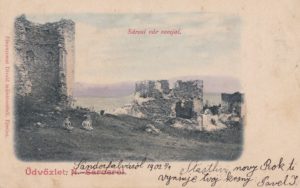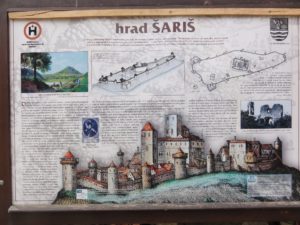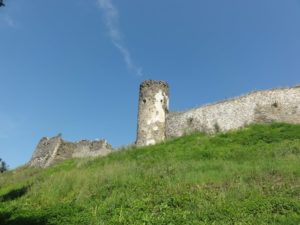Sáros
Sáros aka Nagysáros (Veľký Šariš, Groß-Scharosch) is a settlement in Slovakia, it had been the administrative center of Sáros County in the Kingdom of Hungary until the 18th century.

The history of the settlement
Nagysáros was first mentioned in written sources in 1217 (Sarus). The name of Sáros County and its center is not related to mud, as one might think at first glance. It is precisely the Slovak language that has preserved the more ancient form of its name: Šariš. It is related to our Hungarian word for yellow, “sárarany”, a term related to the washing of gold.

In the middle of the 13th century, Saxon guests and Polish monks of the Augustinian order settled in Nagysáros and lived here until the middle of the 16th century. It was an official place for issuing documents until the end of the 14th century. (This is the predecessor of the present notaries. Documents were authenticated here.)

Its parish church became the religious center of the diocese of Sáros and of Sáros County in 1262. It was King Béla IV of Hungary who granted privileges. At the same time, he gave these rights to Eperjes and Kisszeben. King András III extended this right to the towns of the Szepesség (Zipt) Region in 1299. A century later, King Zsigmond (Sigismund) freed them from the obligation to pay taxes inside the county. In the 14th century, it became the center of the Sáros County. However, the settlement belonged to the local landlord and as a result of this, it lost its city privileges. In 1509, Lord Perényi Imre supported the town’s Latin Protestant school, which ceased to exist in the 18th century.

In the 16th century, it was the largest settlement in the county. In 1635 it was granted the right to hold fairs. It was closely affected by the insurrection of the nobility in the 17th and 18th centuries, as it was owned by the Rákóczi family (from 1642) and then by the Aspremontes (18th century).
The town’s development took place in the 18th and especially in the 19th century when a steam mill was built in 1856, followed by a broadcloth factory (1863). The steam mill’s equipment was destroyed by retreating German soldiers at the end of World War II. But it was the brewery, established in 1967, that made it famous. Today, it is the only Slovak settlement with a street dedicated to Prince Rákóczi Ferenc II.

The history of the castle
Sáros County was a kind of “royal forest county”, it was first mentioned around 1200.
The sparsely populated wooded area along the Tarca and Tapoly rivers was the private hunting ground of the rulers of the Árpád dynasty, the area was supervised by the royal foresters and forest guards. After the Mongolian invasion in 1241, the castle was built on the orders of the Árpád kings, in a place from which the distant surroundings could be kept in view, as well as the trade routes. King Béla the Blind’s daughter was buried in the castle chapel.

Újvár County was divided into three counties: Abaúj, Torna, and Sáros. At that time, the settlement of Sáros became the center of Sáros County, but the seat was moved to Eperjes at the end of the 18th century. The castle was first mentioned in 1262 (castrum Sarus).

The earliest core of the castle was a multi-story old tower, originally 28 meters high, its sides were 13.2 x 13.2 meters long and 4.3 meters thick, built in the middle of the high hill, with a single-story palace attached to the south. This complex of the Comes’ buildings was enclosed by a strong castle wall measuring 34 x 19 meters. The entrance to the tower was on the first floor, and then up a staircase in the wall went to the upper floors.

From the old tower, a 2-meter wooden bridge led to the rampart of the castle wall on the eastern side. The whole castle was surrounded by a deep moat. A separate tower, 9 meters in diameter, was built at this time on the edge of the hillside 150 meters southwest of the small fortress of the Comes, guarding the road to the fortress. This tower became part of the defense system of the large outer castle during the Hussite expansion of the 15th century.

On 12 December 1269, King István the Younger’s envoys signed a treaty with King Charles of Sicily to marry their children, the future King Kun László and Isabella (known as Elisabeth in the Hungarian chronicles). The plan was finalized by King István the Younger at the castle of Sáros. In 1290, the fortress of Sáros and a series of serf villages belonging to it came into the possession of the Soós noble family of Sóvár. On 28 January 1299, King Endre III granted the settlers of Sáros town rights.

Sometime in the early 14th century, the castle was considerably enlarged. The fortifications, with a much thicker stone wall, were already surrounded by a 50 x 32-meter area.
On 10 April 1312, King Károly Róbert’s army encamped around the castle of Sáros, ruled by the sons of Aba Amadé. Since Demeter, the son of Zólyomi Miklós, the lord and castle-keeper of Sáros, was not in the fortress, Henrik, the son of Tarkői Rikalf, commanded the defending army on his behalf. Although they defended it strongly for a few weeks, Henrik, realizing that their position was untenable, made a secret pact with the besiegers.
At the end of April or early May, Henrik and his men beat off the Aba’s men-at-arms and opened the gate to the royal army. As a reward for his treachery, however, he stipulated that he should remain the Comes of Sáros County and the castellan of Sáros castle, while his brother, Master Kakas, should be appointed as the castellan of Szepes castle.

After 13 December 1314, Károly Róbert arrived at Szepes castle, where he dismissed Comes Rikalf’s son Kakas and had his brother Henrik, the castellan of Sáros, arrested because he refused to hand over the castle to him. At the beginning of January 1315, Mikcs of the Clan of Ákos, commander of the royal army, took Sáros from the resisting noblemen of the Rikalf family in a regular siege. Master Mikcs, who began his career at the time, was placed at the head of the occupied fortress. For the next century, the castle of Sáros, the center of a vast domain, remained under royal administration.

To maintain her power, the widow of Szapolyai János invited the Bohemian Czech mercenary general Ján Giskra and his experienced, battle-hardened soldiers to the country. His main task was to prevent the movement of the supporters of the opposing king, Ullászló Jagelló, towards Poland. Giskra’s Hussite soldiers, together with the surrounding countryside, captured the castle of Sáros from the Perényi family. (Please, note that I use the Oriental name order for Hungarians where family names come first.)

Giskra, who was on the side of King László V, fought with varying results against the counter-camp led by Újlaki Miklós and Hunyadi János. During the peace treaties, Giskra repeatedly promised, among other things, to return the fortress of Sáros to its rightful owner, but he failed to do so (1446, 1447). The Czechs held Bishop Hédervári László of Eger prisoner here. In 1455, King László V confirmed the Master of Treasury, Perényi V. János in his domain of Sáros, but the lord was unable to regain it from the Hussites.

It is very likely that between 1441 and 1461 the Hussites were responsible for the expansion of the castle of Sáros, which was relatively small at that time. Since they were known to have won battles through the extensive use of war wagons, they needed a large space for their bases. However, the Hussites adopted the “wagon castle” method (wagenburg) from the Hungarians.

The 4.5–hectare plateau proved to be a very suitable area. The Czech soldiers built a stone wall on the edge of the steep hill, which was divided by circular and horseshoe-shaped towers, the ruins of which are still visible. The gate of the new fortress wall, which enclosed the oval-shaped area, was built on the western side.

King Matthias Corvinus (Hunyadi Mátyás) tried with all his might to break the power of the Bohemian Czechs in the Highlands. On 25 May 1461, our king ordered the citizens of Bártfa (Bardejov) to supply gunpowder, cannons, and arrows for the siege of Sáros and Újvár, which were occupied by the Czechs. Sárvár was then captured by the royal troops.

After 1462 the estate was returned to its rightful owner, the Perényi family. Those who were dissatisfied with King Matthias, led by Archbishop Vitéz János of Esztergom, invited the Polish King Casimir to the Hungarian throne, who camped under the castle of Sáros on 29 October 1471. Here he was joined by the lords of the fortress, Barons Perényi István and Miklós and their noblemen, but he left the country at the end of the year.

The noble conspirators were pardoned, including members of the Perényi family. On 15 November 1483, King Matthias called on the neighboring counties and free royal towns to rise up against the overlord Perényi IV. István, who became a robber knight and was trying to occupy the entire of Upper Hungary. The royal army, led by Both Lábatlan András besieged and took all the castles and estates of Perényi in 1483, including Sáros castle. After 1483, the monarch gave all the freed estates to his son born out of wedlock, Corvin János. Together with other castle manors, he also gave Sáros to him.

At an unknown date, Palatine Szapolyai István acquired the fortress of Sáros together with several serf villages belonging to it. In 1499, after the death of the Palatine, his two sons György and János inherited the huge castle estates. In 1510, Szapolyai János gained the post of the Transylvanian Voivode, thus increasing his influence. On 29 August 1526, after the Battle of Mohács, Szapolyai János became the next king and he appointed his son-in-law, Perényi Péter, the chief Comes of Temes, as the Voivode of Transylvania, and at the same time donated the castle of Sáros to him, but Perényi took the side of his rival, Habsburg Ferdinand.
At the end of June 1537, King Habsburg Ferdinand’s mercenary commander, General Leonhard Vels, besieged the fortress of Sáros. He was victorious in a battle that lasted four or eight weeks.

The fortress of Sáros was of great importance in securing Habsburg rule in Upper Hungary, as it was extremely large compared to the surrounding small fortresses, and thus could accommodate larger troops.

In the 16th century, the well-known humanist scholar George Werhner (1497-1567) became its commander (1538-57). The Silesian-born German poet, naturalist, balneologist, Latinist, a teacher in Kassa (Kaschau, Kosice) and in Eperjes (Presov), also a royal councilor (1535), and a diplomat of King Habsburg Ferdinand I. He published his work on the wonderful waters of Hungary in Latin (“De admirandis Hungariae aquis hypomnemation…” Basel 1549, then Vienna 1551, and several others). This volume laid the foundations for scientific interest in baths. This work has been published until now only in Slovak (1974). The book listed 22 unique water springs that were mainly located in the Upper Lands of the Kingdom of Hungary.

In the summer of 1539, Thomas Lascano, a pro-Hapsburg mercenary commander stationed in Eperjes, wanted to take Kassa from King Szaolyai János. He was joined by the armed German Saxon burghers of the free royal towns of Upper Hungary, and Österreicher Lénárd, the captain of Sáros castle. However, they were defeated by, the army of Czeczey Lénárd, the city commander of Kassa, on 22 July. Lascano himself fell and Österreicher was captured. Only 20 of the garrison soldiers made it back to the castle of Sáros, which was on a high hill.

In 1557, royal commissioners inspected the castle of Sáros. They reported dismal conditions: neglect, and disorder. The royal guard at Sáros, including the castle captain, numbered only 102 men. The castle was surrounded by a weak wall, the hill was covered with trees almost up to the wall, which could easily conceal enemy attacks. However, the Vienna War Council was unable and unwilling to have the fortress built to the technical standards of the time perhaps because it was far from the Turkish battlefields.

In 1560 it was mortgaged by the wealthy Thurzó family. It later passed into the hands of the Báthory family. At the time of Bocskai István’s uprising, the young Báthory Gábor belonged to his camp, so his troops avoided the castle of Sáros. On 5 March 1608, the former Transylvanian prince Rákóczi Zsigmond received the castle dominions of Szádvár and Sáros from the enthroned Báthory Gábor in exchange for his renunciation of Transylvania.
After the death of Rákóczi Zsigmond, his son Baron Pál took Sáros over, and in 1613 a Renaissance fortified palace was built under the castle, near the Tarca River. The Rákóczi family kept the castle and the fortress in good condition and supplied it with strong artillery. During the campaigns of the Transylvanian Prince Bethlen Gábor, Rákóczi György- later prince – was the brother of Pál, who was in Bethlen’s service, so naturally Sáros was not besieged.

In June 1644, Count and Palatine Esterházy Miklós held fruitless negotiations with the envoys of the Transylvanian prince Rákóczi I. György in his camp below the castle. In 1660, the gunpowder tower of the inner castle exploded, causing great damage to the defenses. The explosion was caused by human inattention. After that, the ruined buildings were no longer used, while the outer castle continued to be guarded by the men of the Rákóczi family.

On 14 September 1664, King Leopold appointed Rákóczi I Ferenc, the relative of Rákóczi László as the head of the County, who, after his father’s death, moved back to his estates in the Highlands (northern Hungary) because of the exile decree of the Transylvanian Diet, which had been intimidated by the Turks. He usually stayed in Zboró and Sáros. Because he participated in the Wesselényi Conspiracy, he was forced to let Imperial mercenaries into the fortress of Sáros.

Then the Imperial garrison of Sáros surrendered to Prince Thököly Imre sometime in late 1683. At the same time as the unsuccessful siege of Eperjes, the victorious Polish armies occupied the castle of Sáros, which they burnt down on their retreat from Vienna.
In 1684, Székely Márton, Thököly’s castle captain in Sáros, and his men-at-arms withdrew from the poorly defended castle to escape the attacking Imperial army. Before that, the castle had been damaged and burned in several places with gunpowder. Thus ended the military role of Sáros Castle. From then on, the news reports only mention the inhabitants of the Rákóczi fortified palace below Castle Hill.

It happened here, in Sáros that Prince Rákóczi II Ferenc (1676-1735) was registered as the Chief Comes of Sáros County (1694). The later prince hunted a lot in the area. On 18 April 1701, the future prince was arrested in the castle by the Austrian general Solari, because his letters to the French king had been handed over to the Imperial court by the knight Longueval, a captain of the Baden infantry regiment. The scene was captured in a famous painting by Gyula Benczúr. One more thing about Prince Rákóczi: while he was living in exile in Paris, called himself the Comte de Charoche (Sáros).

Sadly, the fortified palace is no longer there. It is thought to have been deliberately set on fire after the Second World War. It could have been saved, but it was not in the interests of those involved. Since then the castle has been in ruins, waiting for better times. Its history was published in a separate volume by our undeservedly forgotten historian Tuhrinszky Károly in Eperjes in 1899.

Between 1972 and 1981, archaeological excavations were carried out mainly in the inner castle. Around 2001, work began on clearing the castle of its overgrown bush, which is continuing intermittently.
Source: Balassa Zoltán https://felvidek.ma/2020/08/tortenelmi-seta-a-nagysarosi-varhoz/
You can find the location of Nagysáros aka Sáros on Google My Maps here:

Dear Readers, I can only make this content available through small donations or by selling my books or T-shirts:
Please, feel free to support me with a coffee here:
You can check out my books on Amazon or Draft2Digital, they are available in hardcover, paperback, or ebook:
https://www.amazon.com/dp/198020490X or at https://books2read.com/b/boYd81

My work can also be followed and supported on Patreon: Become a Patron!http://Become a Patron!
[wpedon id=”9140″]

https://hungarianottomanwars.myspreadshop.com/all

Here are more pictures of Sáros castle:































